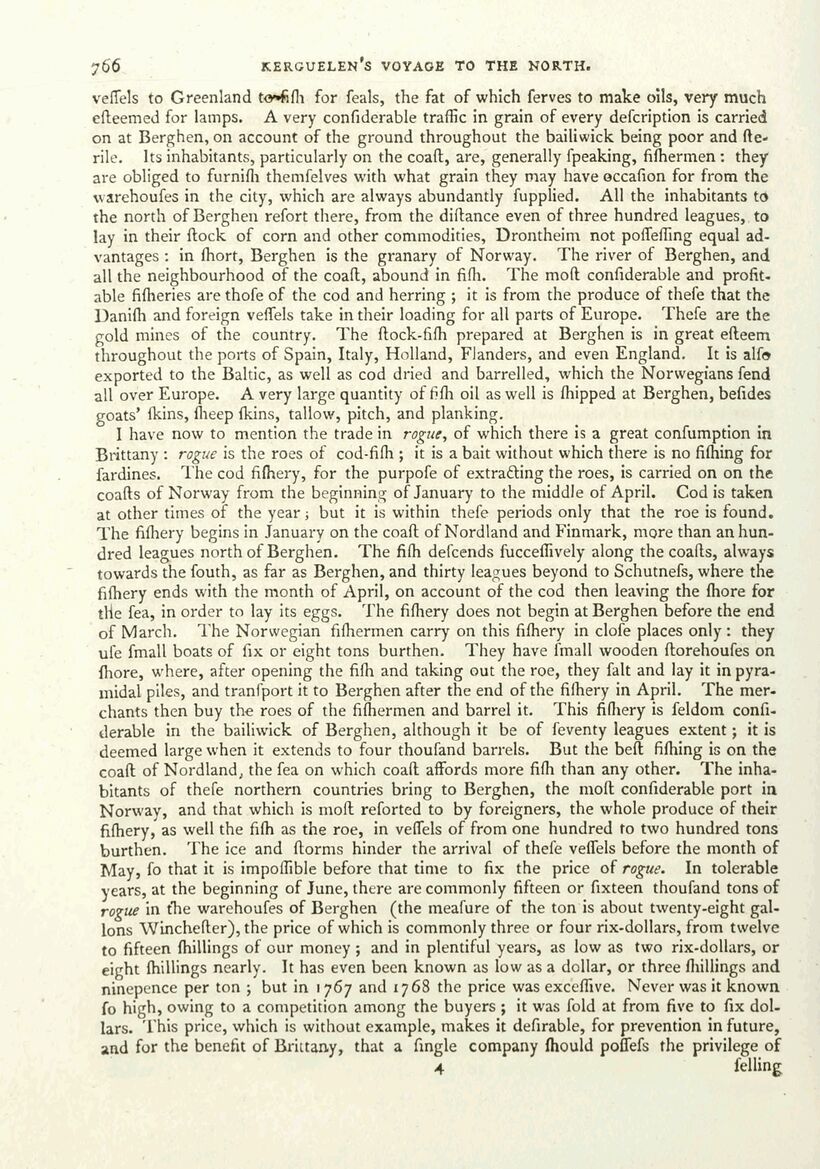
Full resolution (JPEG) - On this page / på denna sida - Pages ...

<< prev. page << föreg. sida << >> nästa sida >> next page >>
Below is the raw OCR text
from the above scanned image.
Do you see an error? Proofread the page now!
Här nedan syns maskintolkade texten från faksimilbilden ovan.
Ser du något fel? Korrekturläs sidan nu!
This page has never been proofread. / Denna sida har aldrig korrekturlästs.
766 KERGUELEN’S VOYAGE TO THE NORTH.
veflels to Greenland te»ffh for feals, the fat of which ferves to make oils, very much
ef{teemed for lamps. A very confiderable traffic in grain of every defcription is carried
on at Berghen, on account of the ground throughout the bailiwick being poor and fte-
rile. Its inhabitants, particularly on the coaft, are, generally fpeaking, fifhermen: they
are obliged to furnifh themfelves with what grain they may have eccafion for from the
warehoufes in the city, which are always abundantly fupplied. All the inhabitants to
the north of Berghen refort there, from the diftance even of three hundred leagues, to
lay in their ftock of corn and other commodities, Drontheim not poflefling equal ad-
vantages: in fhort, Berghen is the granary of Norway. The river of Berghen, and
all the neighbourhood of the coaft, abound in fifth. The moft confiderable and profit-
able fifheries are thofe of the cod and herring ; it is from the produce of thefe that the
Danifh and foreign veffels take in their loading for all parts of Europe. ‘Thefe are the
gold mines of the country. The ftock-fifh prepared at Berghen is in great efteem
throughout the ports of Spain, Italy, Holland, Flanders, and even England. It is alfe
exported to the Baltic, as well as cod dried and barrelled, which the Norwegians fend
all over Europe. A very large quantity of fifh oil as well is fhipped at Berghen, befides
goats’ {kins, fheep fkins, tallow, pitch, and planking.
] have now to mention the trade in rogue, of which there is a great confumption in
Brittany : rogue is the roes of cod-fifh; it is a bait without which there is no fifhing for
fardines. ‘The cod fifhery, for the purpofe of extracting the roes, is carried on on the
coafts of Norway from the beginning of January to the middle of April. Cod is taken
at other times of the year; but it is within thefe periods only that the roe is found.
The fithery begins in January on the coaft of Nordland and Finmark, more than an hun-
dred leagues north of Berghen. ‘The fith defcends fucceflively along the coafts, always
towards the fouth, as far as Berghen, and thirty leagues beyond to Schutnefs, where the
fifhery ends with the month of April, on account of the cod then leaving the fhore for
the fea, in order to lay its eggs. ‘he fifhery does not begin at Berghen before the end
of March. ‘The Norwegian fifhermen carry on this fifhery in clofe places only: they
ule fmall boats of fix or eight tons burthen. They have {mall wooden ftorehoufes on
fhore, where, after opening the fifh and taking out the roe, they falt and lay it in pyra-
midal piles, and tranfport it to Berghen after the end of the fifhery in April. The mer-
chants then buy the roes of the fifhermen and barrel it. This fifhery is feldom confi-
derable in the bailiwick of Berghen, although it be of feventy leagues extent ; it is
deemed large when it extends to four thoufand barrels. But the beft fifhing is on the
coaft of Nordland, the fea on which coaft affords more fifh than any other. The inha-
bitants of thefe northern countries bring to Berghen, the moft confiderable port in
Norway, and that which is moft reforted to by foreigners, the whole produce of their
fifhery, as well the fifh as the roe, in veflels of from one hundred to two hundred tons
burthen. The ice and ftorms hinder the arrival of thefe veffels before the month of
May, fo that it is impoflible before that time to fix the price of rogue. In tolerable
years, at the beginning of June, there are commonly fifteen or fixteen thoufand tons of
rogue in the warehoufes of Berghen (the meafure of the ton is about twenty-eight gal-
lons Winchefter), the price of which is commonly three or four rix-dollars, from twelve
to fifteen fhillings of cur money ; and in plentiful years, as low as two rix-dollars, or
eight fhillings nearly. It has even been known as low asa dollar, or three fhillings and
ninepence per ton ; but in 1767 and 1768 the price was exceflive. Never was it known
fo high, owing to a competition among the buyers; it was fold at from five to fix dol-
lars. ‘This price, which is without example, makes it defirable, for prevention in future,
and for the benefit of Brittany, that a fingle company fhould poffefs the privilege of
4
felling
<< prev. page << föreg. sida << >> nästa sida >> next page >>